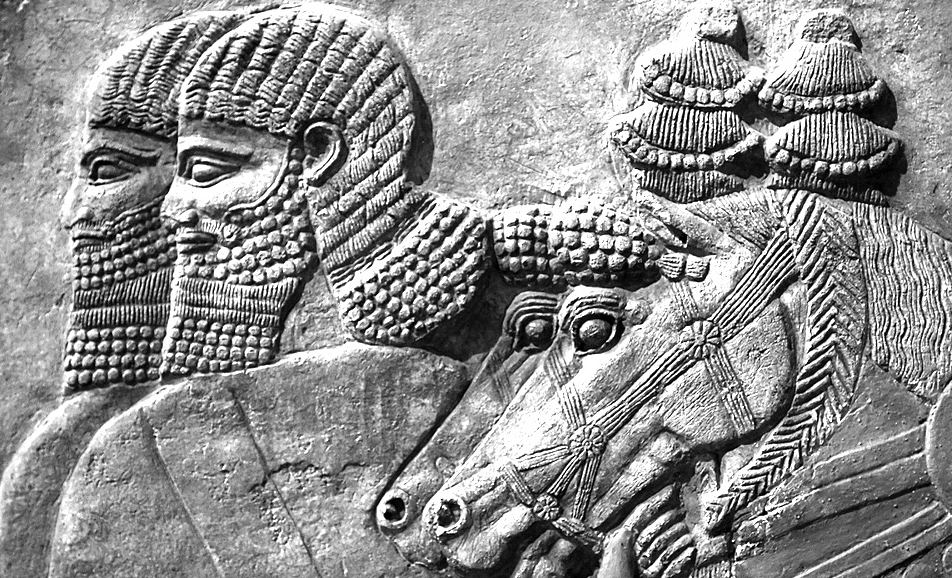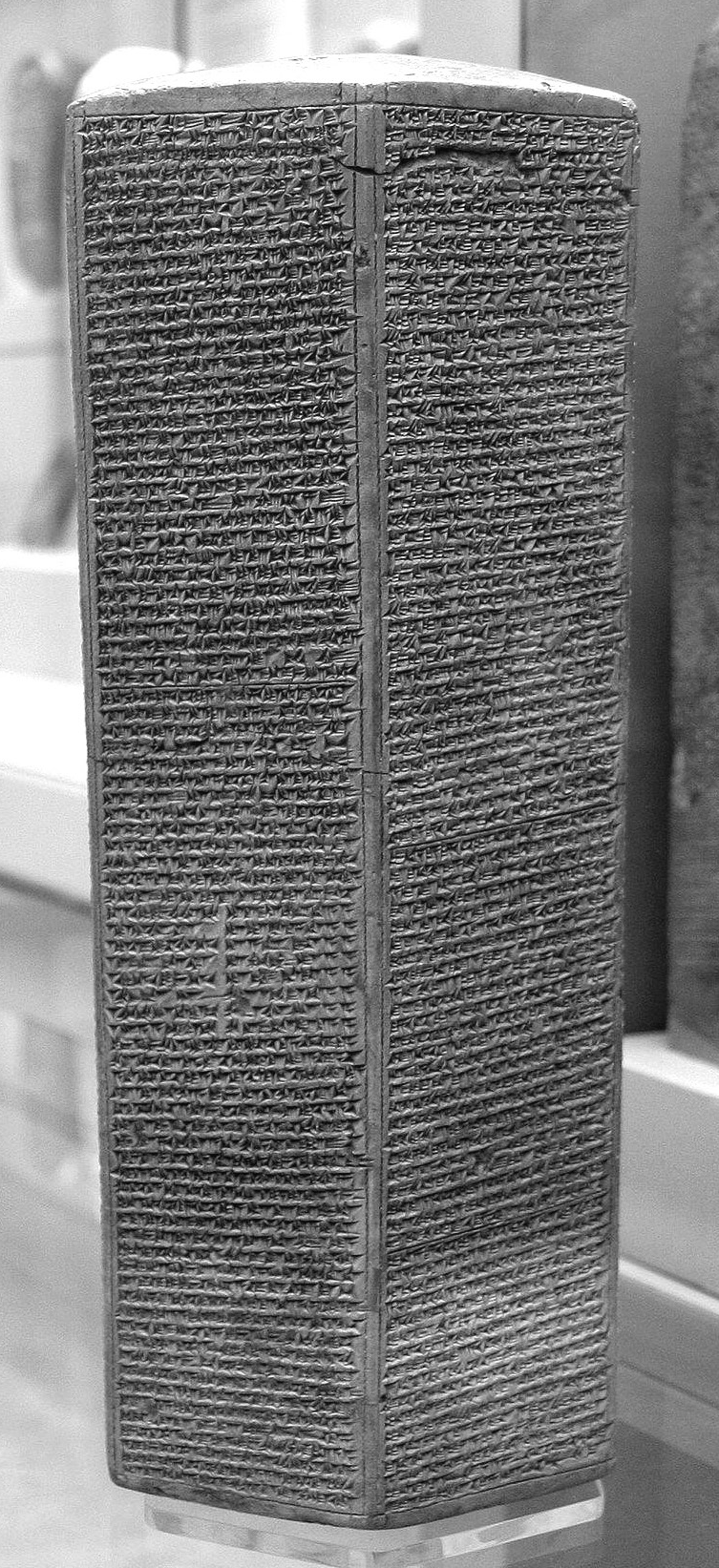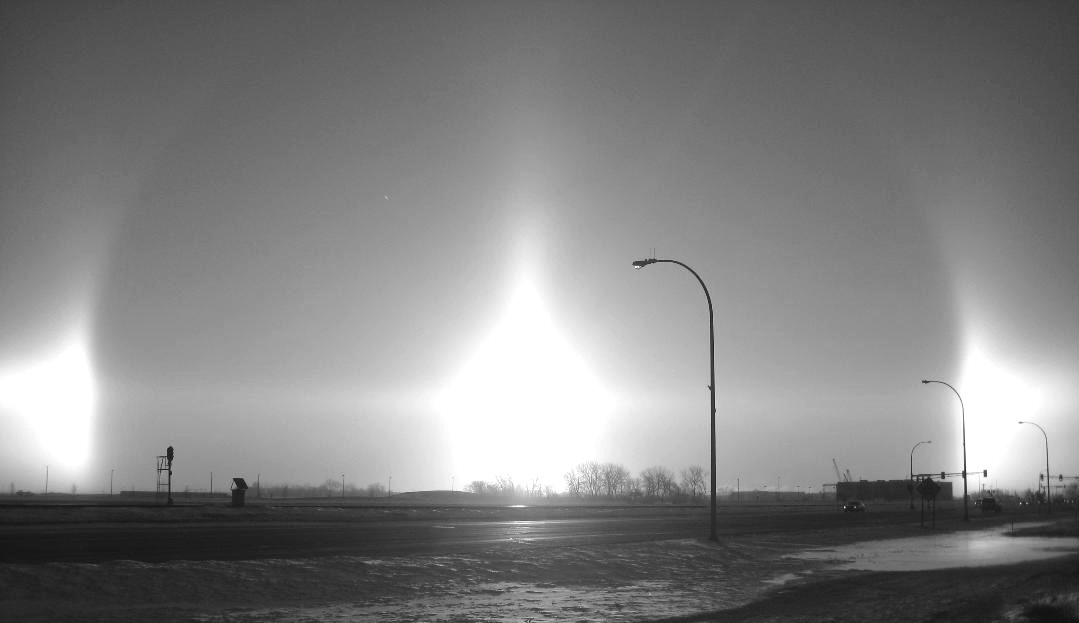Sennacherib’s Cylinder
“He shall not come into this city, nor shoot an arrow there, nor come before it with shields, nor cast a bank against it” (Isaiah 37:33).
Sennacherib’s Cylinder is a six-sided clay tablet discovered by Colonial Robert Taylor in 1830. It was found in the ruins at Nineveh, capital city of the Assyrian Empire. Taylor’s cylinder is presently found in the British Museum. Two additional prisms have been discovered. One is now in the Oriental Institute at the University of Chicago while the third is housed at Israel’s National Museum in Jerusalem. The inscriptions on each are almost identical, although the dates on the prisms show the Oriental Institute prism to be 16 months younger. These cylinders are among the finest archaeological specimens of their kind and their historical and Biblical significance are immense.
Containing 487 lines of very legible cuneiform text, they record eight military expeditions of Sennacherib, king of Assyria. Among them is his description of the siege of Jerusalem during the reign of King Hezekiah. A translation of the complete text can be found in a book titled, The Annals of Sennacherib (University of Chicago Press, 1924).
The words of interest are found in lines eleven to twenty-one. Sennacherib says the following;
SENNACHERIB TEXT
11. “I fixed upon him. And of Hezekiah (king of the)
12. Jews, who had not submitted to my yoke,
13. forty-six of his fenced cities, and the strongholds and the smaller cities
14. which were round about them and which were without number,
15. by the battering rams, and by the attack of engines
16. and by the assaults of foot soldiers, and …”
17. I besieged, I captured 200,150 people, small and great, male and female,
18. horses, and mules, and asses, and camels, and men,
19. and sheep innumerable from their midst I brought out, and
20. I reckoned (them) as spoil. Hezekiah himself like a caged bird within Jerusalem,
21. his royal city I shut in …”
The historical record indicates that Sennacherib devastated the land of Israel. Much of what was written on the cylinder is confirmed by scripture.

Image from the palace of Sennacherib
2 Kings 18:13 says that he came up against all the fenced cities of Judah and took them. He then proceeded to Jerusalem and laid siege.
Prior to Sennacherib’s arrival Hezekiah prepared for war by sealing all the water supplies. Hezekiah’s tunnel was constructed to provide a secret water supply for Jerusalem. Originating outside the city walls at the Gihon Spring, the tunnel takes a winding course of some 1,748 feet, before reaching the Pool of Siloam. It was an engineering marvel as workers dug from opposite ends, meeting somewhere in the middle. 2 Kings 20:20 credits Hezekiah with its construction.
Upon the approach of Sennacherib’s army Hezekiah was also dealing with a severe physical ailment. The words of Isaiah came as a shock to him. “Thus saith the LORD, ‘Set thine house in order; for thou shalt die, and not live’ ” (2 Kings 20:1). This devastating news caused Hezekiah to pray earnestly. As a result, God made a double promise. Hezekiah’s life would be extended 15 years and Jerusalem would be delivered.
The deliverance of the city was swift and decisive. “And it came to pass that night, that the angel of the LORD went out, and smote in the camp of the Assyrians an hundred fourscore and five thousand: and when they arose early in the morning, behold, they were all dead corpses.
So, Sennacherib king of Assyria departed, and went and returned, and dwelt at Nineveh. And it came to pass, as he was worshipping in the house of Nisroch his god, that Adrammelech and Sharezer his sons smote him with the sword: and they escaped into the land of Armenia. And Esarhaddon … reigned in his stead” (2 Kings 19:35-37).
The miraculous defeat of Sennacherib’s army revealed the power of one angel, while the murder of Sennacherib in the temple of his god was an indictment against a false god who could not protect those who worshipped it.
Upon receiving God’s promise of an extended life Hezekiah made an amazing request that God provide a sign that he would be healed.
The Lord, again answered through Isaiah, said, “ This sign shalt thou have of the LORD, that the LORD will do the thing that he hath spoken: shall the shadow go forward ten degrees, or go back ten degrees?’ And Hezekiah answered, ‘It is a light thing for the shadow to go down ten degrees: nay but let the shadow return backward ten degrees.’ And Isaiah the prophet cried unto the LORD: and he brought the shadow ten degrees backward, by which it had gone down in the dial of Ahaz” (2 Kings 20:9-11).
It is interesting that the Lord would give Hezekiah a choice regarding the shadow of the sun, knowing that going forward would not be anything special. And so, Hezekiah chose the latter, the shadow of the sun should go backwards 10 degrees.
As difficult as this may first appear, there is a sound explanation for how this could be easily accomplished.
Halos are often formed around the sun by ice crystals in the atmosphere. These crystals act as prisms to refract or bend the light, creating luminous rings around the sun. These rings may be horizonal or perpendicular around the sun. Under certain conditions a double halo may form in both directions simultaneously. Where the halos intersect bright spots appear that mimic the sun itself. These are called parhelia, par meaning “next to,” helia meaning “sun.” These are also called “mock suns.” With a certain formation of ice crystals, three equally bright suns appear in a row.
To make the shadow of the sun go backwards on the sundial, a thick cloud formation must cover two of the three suns. As the clouds move in from a determined direction, the shadow would move backwards. The account does not say the sun moved backwards, but it was the shadow that was moved on the sundial. If this explanation is correct, it does not minimize the miracle. Miracles are just as impressive because of their timing and circumstances. God often uses natural means to create a miracle but having them occur at the intended moment shows his mastery and control of all things.

Sennacherib Cylinder
As Hezekiah contemplated the gift of life, he described his desire to praise God, saying, “The grave cannot praise thee, death cannot celebrate thee: they that go down into the pit cannot hope for thy truth. It is the living, who give thanks to thee, as I do today; A father tells his son about thy faithfulness. The Lord will surely save me; so we will play my songs on stringed instruments all the days of our life at the house of the Lord” (Isaiah 38:18, 19).
These endearing words of Hezekiah provide an interesting clue that may explain something we find in the Book of Psalms. His reference to “my songs” may be referring to Psalms 120-134. These are titled “A Song of Degrees,” literally “A Song for the Degrees” (See Jamieson, Fausset & Brown). This suggests that the writer had something specific in mind. The word for degrees in the subtitles is the same Hebrew word for the 10 degrees that the shadow went back on the sun dial.

Parhelion Effect, with two mock suns
It has been suggested that these 15 chapters correspond to the 15 years that Hezekiah’s life was extended (See The Companion Bible, Appendix 67). These chapters then comprise the songs of Hezekiah. They are a memorial of the Lord’s deliverance of Jerusalem and the extension of his own life. They contain three repetitive themes. The 15 chapters are divided into 5 sets of three chapters each. The three themes follow each of the chapter divisions.
The first theme is: Distress from the deceit and scorning of others.
The second theme is: Trust in the Lord expressed by God’s people.
The third theme is: Blessings and peace that come to those who trust in Him.
These themes are relevant to all the Lord’s people as they pass through each at one time or another. This was also the experience of Hezekiah, and so these chapters had a deeply personal meaning to him.
In Psalm 124:6-8 Hezekiah’s own experience is clearly referred to when he wrote, “Blessed be the Lord, who hath not given us as a prey to their teeth. Our soul is escaped as a bird out of the snare of the fowlers: The snare is broken and we are escaped. Our help is in the name of the Lord, who made heaven and earth.”
Those sentiments directly relate to Sennacherib’s contention that Hezekiah was like a caged bird. But the reality of what Sennacherib did not say is that the Lord opened the cage and released His people.
From Hezekiah’s experience the Lord’s people can understand there is no enemy who can harm them. There is no fowler who can cage them if they trust in God. He who made heaven and earth is devoted to his faithful people.
— Br. Tom Ruggirello
